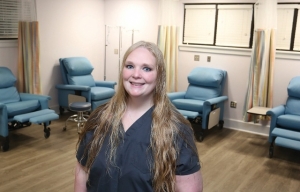Southeastern Medical Oncology Center expands
By Rochelle Moore
Published in News on January 25, 2017 10:13 AM

News-Argus/CASEY MOZINGO
Lead chemotherapy nurse Stacey Casey stands in the new addition at Southeastern Medical Oncology Center. The addition has allowed for six new chairs.
Southeastern Medical Oncology Center is able to serve more clients with the recent expansion of its chemotherapy department,
SMOC, at 203 Cox Blvd., has added an infusion area for non-chemotherapy clients. The new area was added into previously used office space. The expansion also includes a new waiting area alongside the treatment rooms.
"Having more room allows the patient to access treatment sooner," said Dr. I-Wen Chang, oncologist and SMOC partner. "Sometimes in the past, they have waited a half hour to 45 minutes for a (treatment) chair.
"I think its mainly for the comfort of patients and their families so that people don't have to travel to get the services that they need."
The addition of an infusion room allows the separation of chemotherapy patients from non-chemotherapy patients. In the past, all were treated in the same area, said Stacey Casey, chemotherapy lead nurse.
The chemotherapy department includes 16 treatment chairs and one bed, while the infusion area includes six new treatment chairs. The capacity increase overall is the addition of seven new chairs.
"They were all in the same room, and now we're able to separate them," Casey said. "Being able to separate the two better protects the patient, but, at the same time, it allows us to better serve our community.
"In this facility, we average about 55 patients a day, and now we could average up to about 70."
The infusion area includes all non-chemotherapy treatments that can include intravenous antibiotics, iron and saline, vitamin shots, vaccines and rheumatology infusions, Casey said.
Chang said the expansion also helps keep down the cost of medical care by offering treatments that can prevent the need for hospital-based care.
"That's why we want to expand," Chang said. "We can give them fluids here, instead of having them go to the ER or being admitted. We're saving people money."
